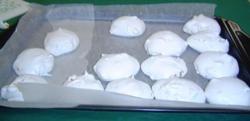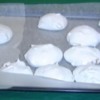Taste and smell are powerful creators of memories.
For some time I've been looking for a "cooking" or "food" connection to the story of the crucifixion that would help teach about the suffering of Jesus on the cross. I've seen and taught the "sweet" cross lessons, like dipping cross-shaped pretzels in chocolate, but wanted to explore the other side of the story, that of the Suffering Servant. Then I ran across this article discussing the "wine mixed with gall" that the soldier gave Jesus on the cross and it instantly reminded me that we DO have a food item to consider in the story of the cross.
The bitter wine, the wine vinegar

In Matthew 27:34 the soldiers offer wine mixed with gall to Jesus and he refuses it. Mark 15:23 calls the gall "myrrh." "Gall" is a generic term for something bitter, and according to the article linked above, bitter wine was a common drink back then, perhaps even used medicinally.
Then when the bystanders think they hear Jesus calling upon Elijah in Matthew 27:48, they offer him bitter wine on a reed. The NRSV called is "wine vinegar."
Is Jesus being offered the same wine twice? Or two different types of wine? The language of Mark and Matthew is unclear and frankly doesn't matter. The point is that Jesus is suffering --for real, and that there were witnesses. That may seem like a moot point to us, but in the early Christian Church the historicity of his death, the reality of his human suffering, and the idea that God would allow his "son" to die like this were all serious questions being debated. Let me suggest that today people STILL ask those very same questions, as will our kids.
Tastes and smells are the memory-forming sensory gold we look for in the Cooking Workshop. I have used the tasting of different food items before in other Cooking Workshop lessons, so I knew that most kids would be willing to smell and taste a small spoonful of vinegar (bitter wine, wine mixed with gall) and that their predictable negative reaction is exactly what I wanted to happen.
Some questions I might ask my kids:
- What does "bitter" mean? Name some "bitter" tasting things. Name some "bitter words" that people sometimes say to each other. Name some "bitter tasting" events or experiences that all people feel at some time in their life. (rejection, put-downs, losing)
 How is vinegar used in cooking and flavoring foods? (salads, bbq sauce, catsup) Explain that vinegar was also used as food additive, as medicine, and as a preservative back then as it is now. Share some pickles.
How is vinegar used in cooking and flavoring foods? (salads, bbq sauce, catsup) Explain that vinegar was also used as food additive, as medicine, and as a preservative back then as it is now. Share some pickles.
- Explain why they had wine and wine vinegar (in those days wine in various recipes and strengths was a staple and safer than water. Wine mixed with medicinal herbs like myrrh may have been used to sedate prisoners).
 If the wine mixed with gall was an act of mercy, what does it say about the soldiers? (See Mk 15:39 for the Centurion's comment that "when he saw how Jesus died.... truly this is...")
If the wine mixed with gall was an act of mercy, what does it say about the soldiers? (See Mk 15:39 for the Centurion's comment that "when he saw how Jesus died.... truly this is...")
- Why did they offer Jesus wine vinegar to keep him alive? (It seems to suggest that some in the crowd still believed Jesus might be the Messiah.)
- If Jesus had died and not come back to life, would you still believe in him? (Read Isaiah 53 the psalm of the Suffering Servant!)
- it is good to remember the sweet parts of the story, the chocolate-covered pretzels and marshmallow "Empty Tomb Crescent Rolls" ...but let's not forget what really happened to Jesus. People like us killed Jesus. it was our sins he took upon himself.
How does that make you feel?
What does that make you want to do in response?
- How does tasting this story "preserve it" in your heart? What do you want to preserve about it?
I might also create a take-home taste-test that shares your lesson. Most homes have vinegar to taste, but maybe not grapes, so if you have time, have some grapes to eat and some to take home. What order should they be tasted? The bitter BEFORE the sweet is like confession before forgiveness. Until we admit our sins we cannot appreciate Jesus' sacrifice for us.
Some More Bible Background
Matthew 27:33
They came to a place called Golgotha (which means “the place of the skull”).
34 There they offered Jesus wine to drink, mixed with gall; but after tasting it, he refused to drink it.
35 When they had crucified him, they divided up his clothes by casting lots.
And again in verse Matthew 27:48
48 Immediately one of them ran and got a sponge. He filled it with wine vinegar, put it on a staff, and offered it to Jesus to drink. 49 The rest said, “Now leave him alone. Let’s see if Elijah comes to save him.”
50 And when Jesus had cried out again in a loud voice, he gave up his spirit.
Culturally speaking, we know that sour or bitter wine was part of the Roman diet. It was apparently a common type of wine drunk by soldiers and the low income, and at times by all people for its medicinal benefits. Paul himself recommends it to Timothy for his stomach (1 Tim 5:23). Most wine in those days was not the clear red we have today, it was often mixed with herbs and sweeteners depending on the cost or use. Today, people drink vinegar as a health additive, to support digestive health, and we use vinegar to preserve foods. The metaphorical possibilities ABOUND! But sometimes details in stories are merely details, and not meant to have deep metaphorical significance.
In the early years of Christianity. the story's details would have initially served as "evidence" to people who had never heard the story, or who questioned its truthfulness. They add a sense of historical authenticity that the crucifixion really happened, that Jesus really suffered and sacrificed himself for our sins. In the early Church, there was a heresy known as "docetism" which denied the suffering of Jesus. Paul mentions certain critics who consider the suffering of Jesus to be a "stumbling block" to belief. And people today have the same problem. Some doubt Jesus ever existed, and they have a hard time believing that God would allow Jesus to die like this. The story needs to be told and remembered to be believed, and thus, being able to unforgettably taste and smell the story creates a teachable moment too good to pass up.












 How is vinegar used in cooking and flavoring foods? (salads, bbq sauce, catsup) Explain that vinegar was also used as food additive, as medicine, and as a preservative back then as it is now. Share some pickles.
How is vinegar used in cooking and flavoring foods? (salads, bbq sauce, catsup) Explain that vinegar was also used as food additive, as medicine, and as a preservative back then as it is now. Share some pickles. If the wine mixed with gall was an act of mercy, what does it say about the soldiers? (See Mk 15:39 for the Centurion's comment that "when he saw how Jesus died.... truly this is...")
If the wine mixed with gall was an act of mercy, what does it say about the soldiers? (See Mk 15:39 for the Centurion's comment that "when he saw how Jesus died.... truly this is...")






